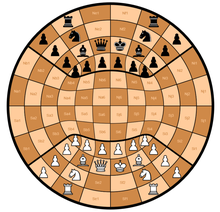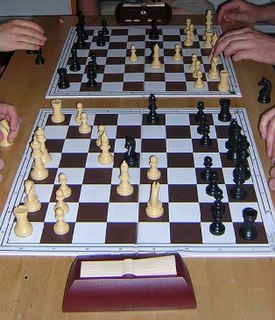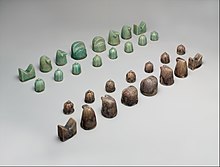Baroque chess is a chess variant invented in 1962 by Robert Abbott. In 1963, at the suggestion of his publisher, he changed the name to Ultima, by which name it is also known. Abbott later considered his invention flawed and suggested amendments to the rules, but these suggestions have been substantially ignored by the gaming community, which continues to play by the 1962 rules. Since the rules for Baroque were first laid down in 1962, some regional variation has arisen, causing the game to diverge from Ultima.

Vernon Rylands Parton was an English chess enthusiast and prolific chess variant inventor, his most renowned variants being Alice chess and Racing Kings. Many of Parton's variants were inspired by the fictional characters and stories in the works of Lewis Carroll. Parton's formal education background, like Lewis Carroll's, was in mathematics. Parton's interests were wide and he was a great believer in Esperanto.
Extinction chess is a chess variant invented by R. Wayne Schmittberger, editor of Games magazine, in 1985. Instead of checkmate as the winning condition, the object of the game is the elimination of all of a particular type of piece of the opponent. In other words, the objective is any of the following:
Kriegspiel is a chess variant invented by Henry Michael Temple in 1899 and based upon the original Kriegsspiel developed by Georg von Reiswitz in 1812. In this game, each player can see their own pieces but not those of their opponent. For this reason, it is necessary to have a third person act as an umpire, with full information about the progress of the game. Players attempt to move on their turns, and the umpire declares their attempts 'legal' or 'illegal'. If the move is illegal, the player tries again; if it is legal, that move stands. Each player is given information about checks and captures. They may also ask the umpire if there are any legal captures with a pawn. Since the position of the opponent's pieces is unknown, Kriegspiel is a game of imperfect information.
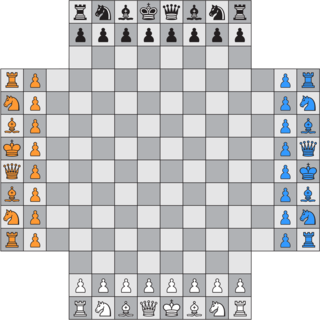
Four-player chess is a family of chess variants played with four people. The game features a special board typically made of a standard 8×8 square, with 3 rows of 8 cells each extending from each side, and requires two sets of differently colored pieces. The rules are similar to, but not the same as, regular chess. There are a variety of different rule variations; most variations, however, share a somewhat similar board and piece setup.
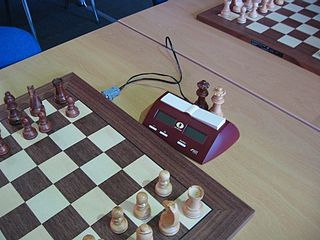
In chess, promotion is the replacement of a pawn with a new piece when the pawn is moved to its last rank. The player replaces the pawn immediately with a queen, rook, bishop, or knight of the same color. The new piece does not have to be a previously captured piece. Promotion is mandatory when moving to the last rank; the pawn cannot remain as a pawn.
Dice chess can refer to a number of chess variants in which dice are used to alter gameplay; specifically that the moves available to each player are determined by rolling a pair of ordinary six-sided dice. There are many different variations of this form of dice chess. One of them is described here.

Microshogi is a modern variant of shogi, with very different rules for promotion, and demotion. Kerry Handscomb of NOST gave it this English name. Although not confirmed, he credits its invention to the late Oyama Yasuharu, one of the most famous professional shogi players in history. The game was invented before 1982.

Hexagonal chess is a group of chess variants played on boards composed of hexagon cells. The best known is Gliński's variant, played on a symmetric 91-cell hexagonal board.

Minichess is a family of chess variants played with regular chess pieces and standard rules, but on a smaller board. The motivation for these variants is to make the game simpler and shorter than standard chess. The first chess-like game implemented on a computer was the 6×6 chess variant Los Alamos chess. The low memory capacity of early computers meant that a reduced board size and a smaller number of pieces were required for the game to be implementable on a computer.
Monochromatic chess is a chess variant with unknown origin. The initial board position and all rules are the same as in regular chess, except that pieces that begin on a black square must always stay on a black square and pieces that begin on a white square must always stay on a white square. This would mean that knights can never move, but The Classified Encyclopedia of Chess Variants says that knights make a double jump. It has been suggested that a knight be replaced with a (3,1)-leaper (camel).
Three-player chess is a family of chess variants specially designed for three players. Many variations of three-player chess have been devised. They usually use a non-standard board, for example, a hexagonal or three-sided board that connects the center cells in a special way. The three armies are differentiated usually by color, with White, Black, and Red serving as the most common color combination.

The following outline is provided as an overview of and topical guide to chess:
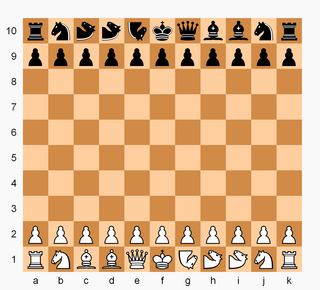
Wildebeest chess is a chess variant created by R. Wayne Schmittberger in 1987. The Wildebeest board is 11×10 squares. Besides the standard chess pieces, each side has two camels and one "wildebeest" - a piece which may move as either a camel or a knight.

Dragonfly is a chess variant invented by Christian Freeling in 1983. There are no queens, and a captured bishop, knight, or rook becomes the property of the capturer, who may play it as their own on a turn to any open square. The board is 7×7 squares, or alternatively a 61-cell hexagon with two additional pawns per side.

Rhombic chess is a chess variant for two players created by Tony Paletta in 1980. The gameboard has an overall hexagonal shape and comprises 72 rhombi in three alternating colors. Each player commands a full set of standard chess pieces.

Chesquerque is a chess variant invented by George R. Dekle Sr. in 1986. The game is played on a board composed of four Alquerque boards combined into a square. Like Alquerque, pieces are positioned on points of intersection and make their moves along marked lines ; as such, the board comprises a 9×9 grid with 81 positions (points) that pieces can move to.
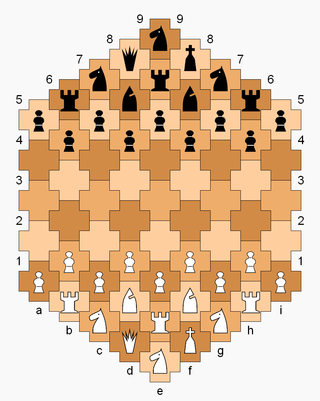
Cross chess is a chess variant invented by George R. Dekle Sr. in 1982. The game is played on a board comprising 61 cross-shaped cells, with players each having an extra rook, knight, and pawn in addition to the standard number of chess pieces. Pieces move in the context of a gameboard with hexagonal cells, but Cross chess has its own definition of ranks and diagonals.

Hostage chess is a chess variant invented by John A. Leslie in 1997. Captured pieces are not eliminated from the game but can reenter active play through drops, similar to shogi. Unlike shogi, the piece a player may drop is one of their own pieces previously captured by the opponent. In exchange, the player returns a previously captured enemy piece which the opponent may drop on a future turn. This is the characteristic feature of the game.
Dynamo chess is a chess variant invented by chess problemists Hans Klüver and Peter Kahl in 1968. The invention was inspired by the closely related variant push chess, invented by Fred Galvin in 1967. The pieces, board, and starting position of Dynamo chess are the same as in orthodox chess, but captures are eliminated and enemy pieces are instead "pushed" or "pulled" off the board. On any given move, a player can make a standard move as in orthodox chess, or execute a "push move" or a "pull move". A move that is either a push move or a pull move is called a "dynamo move".













